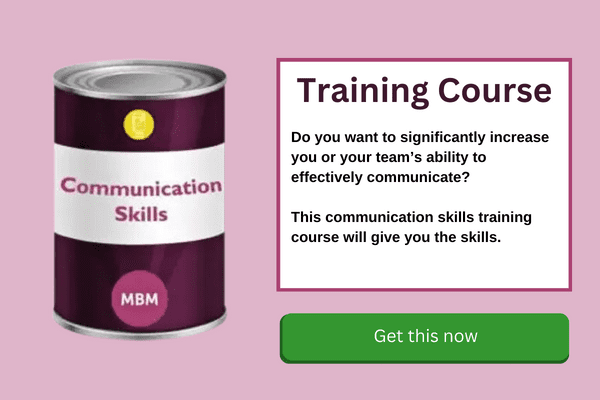Are You Getting the Message Across Successfully?
Effective communication lies at the heart of every successful endeavour. Yet, communication breakdowns persist despite their profound impact. Did you know that these breakdowns cost companies an estimated $62.4 million annually in lost productivity and misunderstandings? The question then arises: Are you truly getting your message across? Luckily, in this article, we delve into the types of communication and offer actionable insights to enhance your communication prowess. While improvement requires effort, the rewards are boundless. After all, continuous refinement of communication abilities is the key to thriving in an evolving business landscape.

Why Do We Communicate?
At its core, effective communication hinges on self-awareness, encapsulated by several key elements:
- Personal Identity: Understanding who you are, your values, and your vision for the organisation sets the foundation for authentic communication.
- Organisational Goals: Clear communication aligns with the broader mission and objectives of the company, guiding actions towards collective success.
- Message Delivery: How you articulate your thoughts and intentions, coupled with strategic planning, ensures your message resonates with the intended audience.
- Feedback Mechanisms: Communication is not a one-way street; it thrives on reciprocal interaction, inviting responses and fostering dialogue to refine understanding.
In general, every communication has three elements:
- Attention: Imagine you’re giving a presentation in a crowded conference room. To capture your audience’s attention, you start with a compelling story or startling statistic related to your topic. By doing so, you ensure that your audience is engaged from the outset, laying the foundation for effective communication.
- Content: Suppose you’re drafting an email to your team about a new project initiative. In the email, you provide clear and concise details about the project’s objectives, timelines, and expected outcomes. You also include relevant supporting information and resources to aid understanding.
- Purpose: Consider a manager conducting a performance review with a team member. The purpose of the communication is not only to provide feedback on the employee’s performance but also to set goals, address concerns, and motivate improvement.
Think about each of these as you use the various types of communication open to you.
Communication is a Numbers Game. Be a Game Raiser and Play to Win
People have come up with lots of lists with numbers, detailing different types of communication. It can be confusing! Sift through them and find inspiration to raise your game, using communication to connect with people and build relationships. Let’s start with an easy one:
2 Types of Communication

- Verbal communication: This happens when we’re speaking with others.
- Non-verbal communication: What we’re doing while we’re speaking often says more than our speech. You can say ‘hi’ to two people with the same words, but your body language can send different messages.
3 Models of Types of Communication
This is more complicated:
1-Linear Communication:
In linear communication, a sender transmits a message to a receiver without immediate feedback, akin to a one-way street. This often occurs in formal settings, such as when senior managers convey directives to their subordinates through different communication channels. While business communication has become less hierarchical, individuals may still communicate differently based on their positions, potentially hindering effective dialogue.
Tip: To enhance communication efficacy, aim to foster a more horizontal exchange of ideas within your team, promoting collaboration and inclusivity.
2-Interactive Communication:
Interactive communication involves a dynamic exchange of messages between sender and receiver, where both parties actively engage in the conversation. This can take place in various forms, such as text chats, phone calls, or face-to-face discussions. For instance, during a team meeting, members share insights, ask questions, and provide feedback, contributing to a collaborative environment.
Tip: To optimise interactive communication, prioritise active listening and encourage open dialogue, fostering meaningful interactions and mutual understanding.
3-Transactional Communication:
Transactional communication entails simultaneous messaging between sender and receiver, with both parties actively participating in the exchange. This occurs in settings where individuals cut across each other, contributing to a vibrant and dynamic conversation. For example, in a brainstorming session, team members bounce ideas off one another, responding and building upon each other’s suggestions in real-time.
Tip: To navigate transactional communication effectively, remain adaptable and flexible in your approach, embracing the fluid nature of the interaction to facilitate productive exchanges.
Be aware of what’s happening when you communicate. You want to connect and build relationships that help achieve your goal. As Shakespeare said, the rest is noise.
The 6 Types of Communication

This next list explores verbal and non-verbal communication in more detail.
1- Non-verbal:
Non-verbal communication encompasses facial expressions, body language, gestures, tone of voice, attire, and emotions, all of which convey messages without words. For instance, during a job interview, a candidate’s confident posture, firm handshake, and maintained eye contact can communicate professionalism and reliability. GAME RAISER: Pay attention to your non-verbal cues, such as body language and facial expressions, to ensure they align with your intended message.
2- Verbal Oral Face-to-face:
This involves direct, spoken interaction between individuals, whether formal or informal, facilitating immediate feedback and clarification. For example, a manager conducts a team meeting to discuss project updates, encouraging dialogue and addressing concerns in real-time. GAME RAISER: Practice meeting people’s eyes in the mirror and perfecting your tone and facial expression. Rehearse role-play before speaking. In the moment, consciously engage your audience’s participation.
3- Verbal-oral-distance:
Utilising technology-mediated platforms such as phone calls, videoconferencing, or webinars for remote communication, enables virtual interaction across distances. Sales representatives conduct a virtual product demonstration for potential clients via video conferencing, showcasing features and also addressing queries. GAME RAISER: Make listening a higher priority than having the last word. Speak slightly lower than when you’re face to face. Reiterate what you understand from listening, paraphrase it, and confirm it’s what the other person meant. Smile as you speak. Also, back it up with written messages where possible.
4- Verbal-written:
Communication is conveyed through written text, including emails, reports, memos, and documentation, allowing for precise dissemination of information. For instance, sending a detailed project proposal via email to stakeholders, outlining objectives, timelines, and deliverables. GAME RAISER: Clarify your context and err on the side of caution!
5- Formal Communication:
Structured and official communication channels within an organisation, typically following established protocols and hierarchies. Examples include issuing company-wide announcements or policy updates through official memos or newsletters.
GAME RAISER: Start by being clear about why you’re doing it. Additionally, have a well-defined structure that people will understand. Moreover, keep your tone open, professional, and friendly. Furthermore, reiterate what you expect to happen after what you’re saying. Also, clarify any constraints on what you’ve shared, like confidentiality. Lastly, if your communication is spoken, back it up with written communication.
6- Informal Communication:
Spontaneous and unofficial exchanges of information among colleagues, often occur outside formal channels, such as watercooler conversations or instant messaging. For instance, sharing project-related insights or seeking advice from coworkers during a casual lunch break. And it can spread like wildfire through grapevine communication. GAME RAISER: Use informal communication to control the grapevine and spread positive ideas or opinions.
What are the 10 Types of Communication?

This next list groups the different communication types in terms of organisational structure, direction, and mode of expression. When communicating at work, think about which type of communication you’re involved in at that moment:
- Formal
- Informal
- Downward
- Upward
- Horizontal
- Diagonal
- Non-verbal
- Verbal
- Oral
- Written
Your communication shapes your business culture. Think about how to make your communication less vertical and more horizontal in the different channels of communication. Make your people feel they’re your team, rather than subordinates to boss around, and they’ll be more productive. Common internal channels include:
- Face-to-face conversations
- Videoconferencing
- Audio-conferencing
- Emails
- Written letters and memos
- Chats and messaging
- Blogs
How Do the Types of Communication Fit?
Think about the different types of communication skills and how they fit together.
Some of the skills in this suggested list from theladders.com might be surprising:
- Written and oral communication
- Attentive listening
- Nonverbal communication
- Politeness
- Brevity, conciseness, and clarity
- Empathy
- Confidence
- Respect
- Open-mindedness
- Constructive criticism
- Discernment of the right communication medium
This list starts with the obvious duo, written and oral communication. But look closely and you’ll see it majors on aspects of emotional intelligence that transform business relationships. As you’ll also notice, this selection puts discernment of the right communication medium last. It’s easy to concentrate on what you’re doing – the medium you’re using – and forget the reason why.
The 7 Essentials of Business Communication
This next list is specifically about formal communication. Communicating effectively in business, says business psychologist Lee Hopkins, needs a solid grasp of these elements:

- Structure
- Clarity
- Consistency
- Medium
- Relevancy
- Primacy or Recency
- The Seven Minus or Plus Two Rule (We did say communication is a numbers game…)
Let’s look at these elements in turn.
#1. Structure
How you structure your communication determines how easily your audience will absorb and understand it. You need an Opening, a Body, and a Close. Sales pitches are built around this sequence: attention, interest, desire and close. The close is key. But that’s not just true of sales. Actually, it’s the same for all communication.
- Craft a Clear Opening: Start with a concise introduction that outlines the purpose of your communication and grabs the audience’s attention.
- Stay On Point in the Body: Present your information logically and sequentially, avoiding tangents or irrelevant details.
- End with Impact: Summarise your key points and reinforce your message with a strong conclusion or call to action.
#2. Clarity
- Define Your Message: Clearly articulate the main idea or objective of your communication to avoid confusion or misinterpretation.
- Stick to One Topic: Keep your communication focused on a single subject to prevent information overload and ensure clarity.
- Practice Conciseness: Use simple language and eliminate unnecessary words or phrases to convey your message efficiently. Even if you know the person you’re dealing with, and you’re confident of their attention. Talking lean is always appreciated!
#3. Consistency
- Maintain Message Alignment: Ensure that your communication remains consistent with your previous interactions and overarching goals.
- Adhere to Established Themes: Keep the tone, style, and also content of your communication uniform to build trust and credibility.
- Consider Long-Term Relationships: Prioritise consistency to nurture enduring connections and strengthen professional rapport. Bear the relationship in mind, rather than just this transaction.
#4. The Medium
- Select Appropriate Channels: Choose communication mediums based on factors such as message complexity, audience preferences, and desired response speed.
You have many options for your business communication. The trick is choosing the right communication channels. Here are some options:
- Speech.
- Paper-based memo or letter.
- One-to-one face-to-face presentation.
- One-to-many in-person presentation or speech.
- One-to-one phone presentation.
- One-to-many phone presentation/conference call.
- Text-only email or phone text.
- Video conferences, including Zoom and Teams.
- Webpages and social media around it.
- Web video.
- Radio broadcast.
- TV broadcast.
- Press release.
- CD, USB stick, DVD.
- Visual communication.
- Posters.
- Displays.
- Advertising.
- Literature.
The Words are Important. But Don’t Forget the VISUALS!

Visual communication complements the other types of communication well. Moreover, visuals can help make your communication less formal, more intimate, and more approachable. Additionally, visual communication delivers information, messages, and points using graphic design and visual aids. Furthermore, common examples include photos, slide presentations, diagrams, physical models, drawings, illustrations, and videos. By using visual communication alongside verbal, nonverbal, and written communication, you can help people grasp and also understand your message sooner.
Coming back to Essential #4: The Medium, base your choice of media on these 4 factors:
- The message you wish to communicate.
- Where you and the other people are located, and how many of them there are.
- The speed and nature of the response you want.
- The budget available and the urgency of the message.
#5. Relevancy
- Know Your Audience: Identify the interests and needs of your target audience to tailor your types of communication and make it more relevant.
- Focus on Value: Deliver content that is informative, engaging, and directly applicable to the recipient’s concerns or objectives.
- Cut Through the Noise: Capture attention by presenting compelling and impactful messages that resonate with your audience’s priorities.
#6. Primacy/Recency
Experts say we remember a piece of business communication because of the power and memorability of its opening or closing. Better still, both. Psychologists call this the primacy effect. Similarly, we recall the last few things we’re presented with. This is called a recency effect. For best results:
- Craft Memorable Beginnings: Start your communication with a strong opening statement or hook to capture the audience’s attention from the outset.
- End with Impact: Conclude your communication with a clear call to action or key takeaway to leave a lasting impression on the recipient.
- Balance Structure: While primacy and recency are essential, ensure that your communication’s body remains coherent and substantive, don’t forget #1 in Lee Hopkins’ list of 7 Essentials, the structure. Get the body right first, then concentrate on the opening and the closing.
#7. The Seven Minus or Plus Two (7+2) Rule
Here’s a handy hack for happy endings in your communication. It’s less complicated than it sounds.
However intelligent we are, our brains can only retain so much short-term memory. And they’re structured to store it in clusters, or groups of items. Research into human beings around the world shows these clusters consistently average seven items, plus or minus two. Make your key action points more memorable by limiting the number to 7, plus or minus 2. Ideally, have no more than 5. This fits in with our article on the Five Priorities model something else to help in thinking about your communication, particularly what goes into the body of it.
And Finally: What are YOUR Company’s preferred types of Communication? Follow These Steps to Build Up Your Team’s Communication Skills

Developing a Comprehensive Communication Strategy:
1-Define Objectives:
Begin by clearly defining the objectives and outcomes you aim to achieve through your communication efforts. Whether it’s enhancing brand awareness, driving sales, or improving employee engagement, establish specific, measurable goals that align with your organisation’s strategic priorities.
2-Identify Target Audiences:
Identify the key stakeholders you need to engage with to achieve your objectives. This may include internal audiences such as employees and executives, as well as external stakeholders such as customers, investors, media, and community members.
3-Craft Key Messages:
Develop key messages that resonate with each target audience and support your communication objectives. Moreover, ensure that these messages are clear, concise, and aligned with your brand identity and values.
4-Select the Communication Channels:
Determine the most effective channels and platforms for reaching your target audiences. Consider a mix of traditional channels (e.g., email, newsletters, press releases) and digital platforms (e.g., social media, website, blogs) based on audience preferences and communication objectives.
5-Create Content Plan:
Develop a content plan outlining the topics, formats, and also timelines for your communication materials. Moreover, consider the frequency of communication, content themes, and seasonal trends to ensure relevance and engagement.
6-Implement Monitoring and Evaluation:
Establish metrics and KPIs to measure the effectiveness of your communication efforts. Track key metrics such as audience reach, engagement levels, sentiment analysis, and conversion rates to evaluate performance and inform future strategies.
7-Iterate and Adapt:
Lastly, continuously monitor and assess the results of your communication initiatives. Additionally, be prepared to iterate and adapt your strategy based on feedback and evolving business needs. Furthermore, regularly review and refine your communication tactics to optimise performance and drive continuous improvement.
When you’re looking to improve your team’s communication, work on these key steps:
- Understand the full spectrum of communication skills.
- Verbal skills.
- Listening skills.
- Writing skills.
- Tech communication skills.
- Social graces: be assertive, but be kind, too.
- Body language.
- Emotional intelligence.
- Personal presentation.
Some Helpful Activities…

Encourage your team to develop these communication skills and work on bettering their different types of communication. Now the following specific activities will help:
- Do more talking in person: Sitting at a computer all day can lead to serious impairments in communication skills. Encourage your team to get up, walk about and also talk to colleagues face to face. Short team meetings are good for getting people to speak to each other in person. It’s also good for leadership to leave their office and discuss tasks and projects with their teams.
- Encourage participation in speaking: Your team members may have poor communication skills because they’ve not had opportunities to practise. Find ways to help them improve their speaking skills. Start with more team discussions.
- Focus on listening: As a leader, model the value of listening to what others are saying and asking questions to clarify what they mean. Encourage team members to listen actively to colleagues and also others they work with. This is particularly important for people who work with clients and need to reach workable solutions and co-creation.
- Ask open-ended questions: This will have a positive effect on communication and foster creative solutions to workplace problems. Asking people what solutions they suggest, is more inviting than simply presenting the approach you want implemented.
- Pay attention to body language and tone of voice: Speaking face to face is about more than what’s said. Model body language, and always adopt a friendly, welcoming tone of voice. Remember to lead by example and others will follow.
All in all, staying open and receptive to different types of communication will make you more productive and also enrich your life. And there’s always more to learn.
Conclusion
As we mentioned earlier, it’s crucial to be aware of WHY you’re communicating. Therefore, all your communication should serve your company vision and move you closer to your goals. Additionally, ensure that your communication advances your mission and objectives. Furthermore, monitor how people react and respond appropriately. Lastly, remember that every communication comprises three elements – attention, content, and purpose. Reflecting on each of these elements will assist you in optimising every type of communication.
Updated on: March 25, 2024




